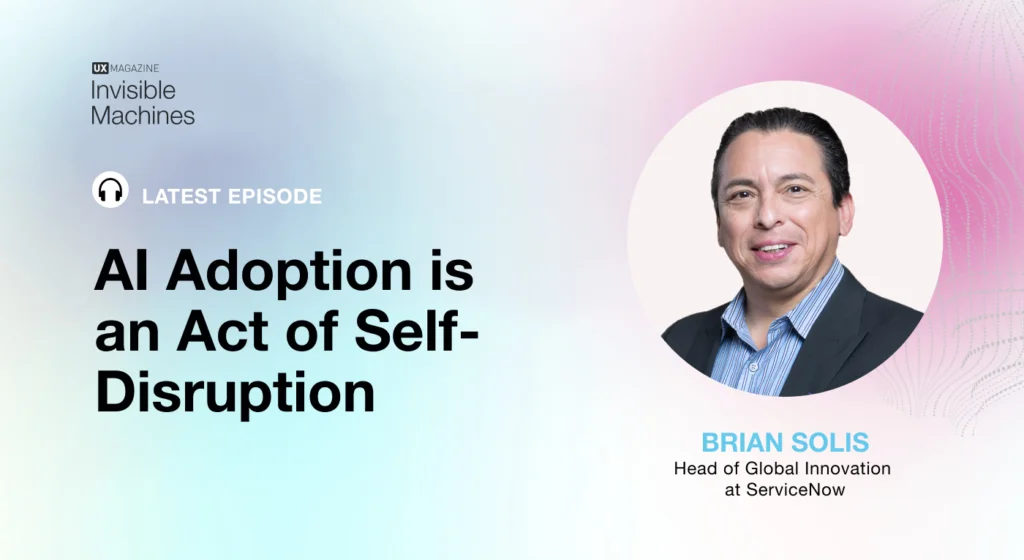The way we interact with technology is quickly moving from the screens in our pockets into the physical world around us. Smart homes, autonomous cars, cloud-based healthcare, and wearables are just some of the connected products currently dominating this conversation. With a predicted 50 billion connected products in market by 2020, UX designers will need to expand their view and be more collaborative than ever as they take on the many challenges and opportunities that come with this ever-expanding definition of omnichannel.
The good news is many of the UX principles we’ve defined in designing digital products will hold true in the highly connected environments of tomorrow. The even better news is that, as UX designers, we’re inheriting a hugely expanded set of tools and challenges as we collaborate more and more with architects, automobile designers, civil engineers, city planners, industrial designers, behavioral psychologists, and interior designers, to name a few.
Form Follows Function
As digital UX designers, we are only the most recent practice to take a seat at the experience design table. Architects and industrial designers, for example, have been taking a people-first approach to problem solving for a very long time—carefully considering how people develop mental models of the spaces they move through, or accounting for a variety of hand sizes and grip strengths when designing the handle of an ergonomically superior tool. Designing these products and experiences employs many of the same principles we use as digital UX designers, but there’s also a lot of expertise specific to these disciplines that we will need to become familiar with. We have a lot to learn from industries that have been designing user experiences for literally hundreds of years, and one of the most important things might just be the idea of justified design.
Justified Design
For the past year or so at Smashing Ideas, we’ve been working with a very old, very large physical technology company with thousands of employees spread across the world. To say they have rigorous processes in place would be selling it very short. Everything they (and now, we) do has been subject to what we’ll call justified design.
Justifying your design decisions means being able to prove they have a direct relationship to the needs of the user as agreed upon during the course of research and testing. This gets into things like very specific acceptance criteria and ultimately, requirements traceability. When you’re designing something that has to pass the scrutiny of regulatory bodies like the FDA and FAA, you absolutely want systems in place that ensure compliance and traceability. At the same time, we don’t want our design thinking to be so driven by rigid process that we end up with a digital experience that’s lacking in inspiration, originality and emotion.
Working with the Physical
So here’s what this looks like in reality. We worked closely with Mattel, and their technology partner Cywee in Taiwan, to create Barbie Digital Makeover—a virtual mirror that uses real-time face-tracking and a Bluetooth-connected makeup wand. Our designers and developers worked with physical prototypes that ranged from a plywood box packed with sensors and wires to progressively more complete versions of the toy.
Never lose sight of the marriage of physical objects and the digital screens you’re designing for
As a UX designer, you can begin to imagine the very long list of user stories, conditional states, and related UX design challenges that emerge from the marriage of the physical toy and the iPad (kids slide the iPad into the light-ringed vanity frame which sits atop a base covered in physical UI), as well as the combination of BTLE makeup wand and face-tracking (kids are instructed to center the wand and then their face in view of the iPad to initiate tracking of each).
Two critical things to keep in mind here are: 1) never lose sight of the marriage of physical objects and the digital screens and devices we’re more used to designing for, and 2) wireframes and flows should illustrate all parts of the experience. With Barbie Digital Makeover as the continued example, if an iPad sits inside a plastic frame, include the frame in your wires and flows. This will reveal problems and opportunities that might be missed if only the digital screens are accounted for (see more here).
Advice on Partnering with Physical Tech
It’s important to note that in our role as digital partners—and because the physical products are often designed well in advance of their digital complement—what we do doesn’t always influence industrial design decisions, but can very much inform changes to how the firmware works. Below are some key insights we’ve found useful when collaborating with our physical technology partners. While many of these will be familiar, the important thing to keep in mind is your physical product partner’s amplified focus on justified design within each.
Design Advocacy
Aligning efforts and proactively seeking collaboration with your client-side counterparts is always good practice, but here it becomes more critical than ever. These folks are steeped in domain knowledge, often have a backlog of ideas, and will ultimately be your inside track to shepherding your award-winning concepts across the finish line. Make them as much a part of user story writing, story mapping, prototype testing, and any other aspect of development as you can. For example, we reserve rooms and desks in our office for our client-side peers to set up camp right next to our teams. There’s no substitute for this “one room” dynamic.
For physical technology partnerships specifically, collaborating with engineers as early as possible will yield better results. Revealing insights through good UX research can still lead to changes in the physical technology. For example, in a recent project our early research and testing revealed that the inclusion of a clock as part of the connected physical object would be important to its success. As a result, the decision was made to increase the cost of each unit by adding a microchip.
Research and Testing
Clients will often have years of very expensive research, complete with personas and consumer decision journeys, ready to inform the product and experience you’ve been challenged with designing. Because the existing research is often either marketing- or physical product-focused, Creative Directors and UX designers must be a part of all new research and testing efforts from the start—ensuring the inclusion of the more subjective concepts and features that will result in a digital/physical experience with heart.
On a more practical level, my advice is to include the connected physical technology (the ubiquitous computing object) in testing as soon as humanly possible. As any good UX designer knows, we can make as many smart assumptions as we want and they might look great on paper, but there’s nothing like testing even the most lo-fidelity version of something to quickly prove or disprove those assumptions. With connected experiences like these, the margin for error in assumptions multiplies.
Pitching the Imaginative
Successfully pitching an imaginative concept that uses, for example, New Yorker-style illustrations and a game-like journey for a digital/physical connected experience meant to help diabetes patients, can be much tougher than getting everyone on board with a concept or feature that simply responds to the known needs of those same diabetes patients. It can seem subjective or even silly to a client who must approve all design decisions. But, of course, a more imaginative concept or feature can also prove to be more valuable, motivating, and memorable for its audience. As such, it becomes our job to justify these design decisions or at least narrow the gap for their leap-of-faith.
One of the things we’ve found useful in gaining support for these harder to defend ideas is to write a magazine article or faux press release that envisions the product in market. Even though it will invariably change or evolve, this can act as a North Star for everyone as we move forward. In the end, even the most imaginative concepts will need to be proven through testing and justified by sound design thinking. There isn’t much room for guesswork here.
Protecting the Idea
Success! You got the first group of stakeholders on board with your imaginative idea. Now you’ll want to provide them with the materials to champion it and, more importantly, defend it as it makes the rounds to higher-ups and different departments internally. You’ll want decks and prototypes that describe not just the proposed feature or experience, but the research, insights, and design decisions that allow stakeholders a traceable view of your design thinking.
Research to Realization, Under One Roof
At this level of engagement—where large physical technology companies might typically work with one company for research or design, then take those designs to another company for development—we’re firm believers that the best results come from partnering with clients throughout every step of development. This unbroken collaboration, from research to insight to design, development, and launch is what leads to original and valuable experiences and products. The best example we have of this is our partnership with a leading consumer electronics manufacturer. We worked closely with them to research and validate a value proposition for a connected product. The physical product uses built-in Bluetooth, gyroscope, accelerometer, and haptic feedback and connects with phones or tablets.
Things like contextual inquiry and exhaustive experience mapping become critical to success when working with connected physical tech. For this project, the contextual research was done in-home, which allowed us to identify and refine the key insights that created the foundation of the value proposition. Getting a clear picture of how, when, and why users interact with each touchpoint throughout their home over the course of a day was invaluable in informing the experience we designed. My advice: educate the client on the importance of UX research and be as exhaustive as you can in mapping the experience.
Informed Intuition
When designing connected experiences that bridge the digital/physical divide within even the most challenging, rigorous processes, we need to remember that people are wildly individual, emotional decision-makers, who are enchanted by the imaginative. As a result, the most meaningful, motivating, and valuable experiences will always include some intuition and imagination. We just have to try harder to justify the design thinking behind them when working with our physical technology partners.







